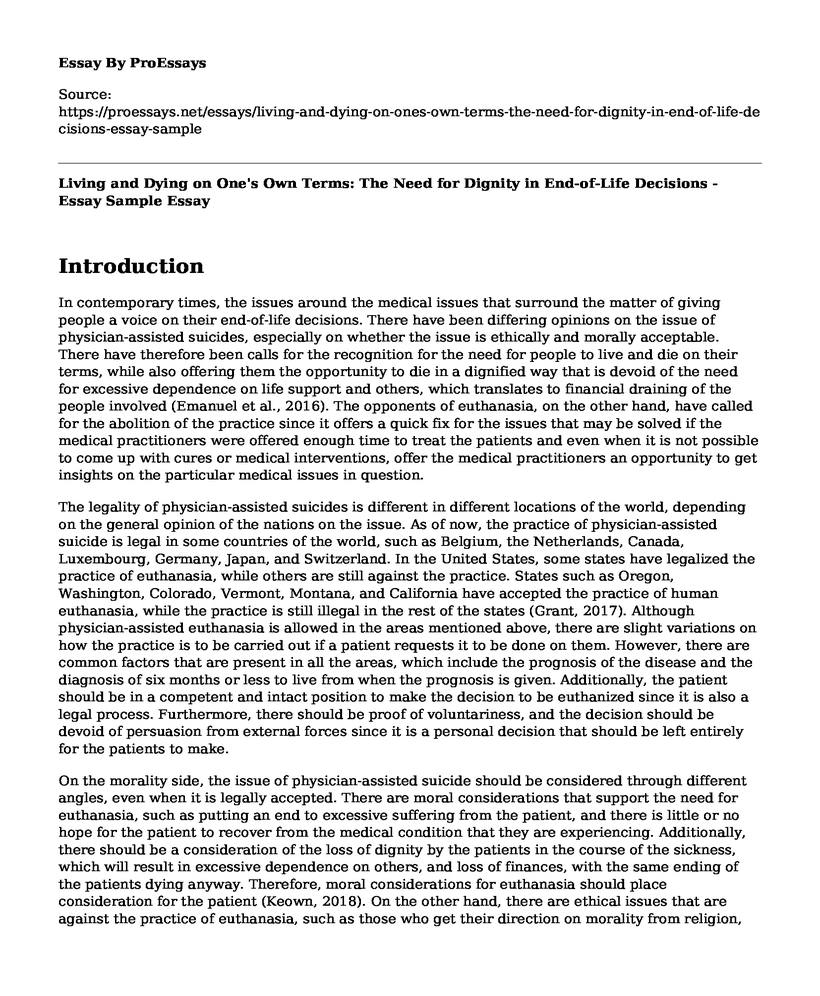Introduction
In contemporary times, the issues around the medical issues that surround the matter of giving people a voice on their end-of-life decisions. There have been differing opinions on the issue of physician-assisted suicides, especially on whether the issue is ethically and morally acceptable. There have therefore been calls for the recognition for the need for people to live and die on their terms, while also offering them the opportunity to die in a dignified way that is devoid of the need for excessive dependence on life support and others, which translates to financial draining of the people involved (Emanuel et al., 2016). The opponents of euthanasia, on the other hand, have called for the abolition of the practice since it offers a quick fix for the issues that may be solved if the medical practitioners were offered enough time to treat the patients and even when it is not possible to come up with cures or medical interventions, offer the medical practitioners an opportunity to get insights on the particular medical issues in question.
The legality of physician-assisted suicides is different in different locations of the world, depending on the general opinion of the nations on the issue. As of now, the practice of physician-assisted suicide is legal in some countries of the world, such as Belgium, the Netherlands, Canada, Luxembourg, Germany, Japan, and Switzerland. In the United States, some states have legalized the practice of euthanasia, while others are still against the practice. States such as Oregon, Washington, Colorado, Vermont, Montana, and California have accepted the practice of human euthanasia, while the practice is still illegal in the rest of the states (Grant, 2017). Although physician-assisted euthanasia is allowed in the areas mentioned above, there are slight variations on how the practice is to be carried out if a patient requests it to be done on them. However, there are common factors that are present in all the areas, which include the prognosis of the disease and the diagnosis of six months or less to live from when the prognosis is given. Additionally, the patient should be in a competent and intact position to make the decision to be euthanized since it is also a legal process. Furthermore, there should be proof of voluntariness, and the decision should be devoid of persuasion from external forces since it is a personal decision that should be left entirely for the patients to make.
On the morality side, the issue of physician-assisted suicide should be considered through different angles, even when it is legally accepted. There are moral considerations that support the need for euthanasia, such as putting an end to excessive suffering from the patient, and there is little or no hope for the patient to recover from the medical condition that they are experiencing. Additionally, there should be a consideration of the loss of dignity by the patients in the course of the sickness, which will result in excessive dependence on others, and loss of finances, with the same ending of the patients dying anyway. Therefore, moral considerations for euthanasia should place consideration for the patient (Keown, 2018). On the other hand, there are ethical issues that are against the practice of euthanasia, such as those who get their direction on morality from religion, since religious morals dictate that life comes from God. Only God has the right to take the life of people, not themselves, or medical practitioners. Additionally, there has been the moral issue on the creation of a slippery slope, where people other than the patients can use the possibility of physician-assisted suicide to accomplish their personal and selfish needs that do not necessarily serve the needs of the patient, thus leading to the death of people who should not have died from the medical conditions.
References
Emanuel, E. J., Onwuteaka-Philipsen, B. D., Urwin, J. W., & Cohen, J. (2016). Attitudes and practices of euthanasia and physician-assisted suicide in the United States, Canada, and Europe. Jama, 316(1), 79-90.
Grant, E. (2017). Legal/Legislative Issues in Euthanasia and Physician-Assisted Suicide. The Catholic Lawyer, 36(3), 6.
Keown, J. (2018). Euthanasia, ethics, and public policy: an argument against legalization. Cambridge University Press.
Cite this page
Living and Dying on One's Own Terms: The Need for Dignity in End-of-Life Decisions - Essay Sample. (2023, Aug 28). Retrieved from https://proessays.net/essays/living-and-dying-on-ones-own-terms-the-need-for-dignity-in-end-of-life-decisions-essay-sample
If you are the original author of this essay and no longer wish to have it published on the ProEssays website, please click below to request its removal:
- Knowledge Sharing in Decision-Making Essay
- How a Nurse Leader Helps a Nurse Colleague Pursue Their Professional Goals Essay
- Essay Sample on Moral Principles to Moral Dilemmas in Medicine
- Creative Profile Thinking - Paper Example
- COVID-19: Impact on Small Business Supply Chains - Essay Sample
- Paper Example on Creating Precise Budgets for Hospitals: Fund Management for Success
- Regulatory Affairs: Ensuring Compliance & Guiding Corporations - Essay Sample







